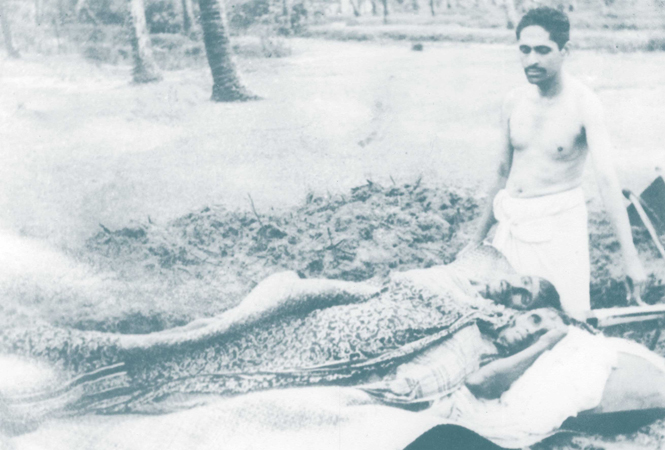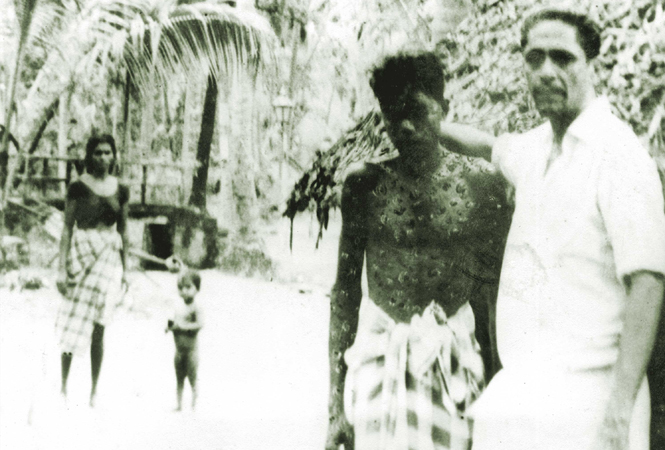Diseases
Posted in : Uncategorized on by : admin Comments:
Cholera Epidemic
The costal belt of Kerala and in particular Vypin Island, near Kochi were exposed to cholera epidemic on a seasonal basis due to various reasons such as climate change, unhealthy seasonal food consumption, and lack of general hygiene. Cholera attack is under control these days due to better living standards and improved health care.

During the days of late Sarvodayam Kurian, it was difficult to contain the epidemic due to limited medical care access. Kurian initiated the free cholera vaccine scheme through the support of Government Health Department. With help of several youth from the Island, Kurian educated the public on the need of taking the preventive vaccination. They used to visit all major junctions of the Island and announce the place, date and the time when free vaccine would be provided. Punctually arriving on his bicycle, Kurian would supervise the vaccination of thousands of Islanders. This immensely helped control the epidemic and save several lives.
During the time of cholera epidemic, especially in 1964 and 1982, the unfortunate victims were left with hardly any health care as there were only three primary health centres for a few million inhabitants. People died like flies. Even family members were afraid of burying their diseased for fear of contracting deadly cholera. Kurian would pick up the dead body with the help of few local good Samaritans.
It was during one such epidemic, Kurian introduced the first Free Stretcher Service in Vypin Island. Even though the use of stretcher is free in the Island, two or four people are required for carrying patients or dead body. Among the brave men who came forward, Kurian would be the first one to volunteer. Kurian used to print hand bills containing precautionary warnings to prevent spread of cholera, and personally go round on his cycle distributing them.
Small Pox
The deadly Small Pox was one of the major killers in the Island with no treatment due to the virus out break and lack of proper and timely medical attention. None of the medical centres nor hospitals could accommodate the patients because of the infectious nature of the decease and lack of medicines to treat the disease. Majority of the infected patients ended up losing life.

However, thanks to World Health Organization’s Small Pox Eradication, Kurian took instant measure to implement it in the Island just as he did for the Cholera Vaccine Immunization. Along with several young men and women volunteers, Kurian went on his bicycle visiting every junction in Vypin Island creating public awareness on Small Pox prevention and cure. The young Samaritans were always his strength.
The majority of the infected Small Pox patients end up dying in most of the cases at home, often not attended even by close relatives. In the torrid tropical conditions, the dead body begins to decay fast. As soon as Kurian heard about any unattended dead body in the Island, he moved in and picked up the body for its last rites. In most cases, he had to do it single handedly, as people were afraid of the communicable disease. Often he would role up the body in bed sheet or straw mat (paya). After tying it up with ropes he loaded it at the back of his bicycle and went straight to the graveyard for burial.
There are two memorable experiences worth mentioning.
Once, for lack of time and volunteers to dig graves, Kurian had two dead bodies buried in one grave.
On another occasion, Kurian took a presumably dead Small Pox victim to bury and it started moving during the burial as death had not occurred. As the body showed signs of life it was taken back home.
Kurian may not have saved many lives but single handedly helped many infected Small Pox victims. Whoever survived with the deep scars Small Pox left on their body for the rest of their life recall with fond memory Kurian’s love and care that saved them.
Chicken Pox
Chicken Pox was another virus infection, but far lighter compared to Small Pox. An infectious disease, it is communicable among close associates especially the family members. Not as dangerous as Small Pox, the casualty is far less, if no other complications are associated. The virus can keep the patient home bound for about two weeks. However, being communicable, loved ones stayed away. Compared with Small Pox, the scars are lighter and most disappear in two or three months.
As the annual Chicken Pox season arrives, Kurian makes rounds on his bicycle visiting the patient and the family, gives possible medication and advise. He leaves only after educating the rest of the family members and neighbours how to avoid spreading the disease. Senior Islanders still remember Kurian making his communicable disease prevention awareness rounds
Sarvodayam Kurian was highly sensitive to TB patients, a very common sickness in his days. To meet the rising demand for the treatment of TB patients, Kurian decided to build and hand over a TB ward to the Government of Kerala at Narakal. The corner stone of the ward was laid by then honorable Minister of Health late Mr. K. M. George. Kurian made sure that the patients received egg and milk along with their daily does of medicines.
Tuberculosis
A rare and curable disease these days, Tuberculosis (TB) was widespread disease in Kurian’s days. Considering the number of patients who could not have two meals and proper medication, Kurian decided to finance, build and handover, a 15-bed TB ward to Narakkal Government Hospital. He made sure to visit the patients daily and follow up their diet which included egg and milk among others. Also, if required, the medicines such as Streptomycin, INH and PAS were also provided, if the same was not available at the Government Hospital.
Leprosi
The number of cases were very high and Kurian was a regular visitor to The Leprosy Sanatorium at Koratty, with his contributions of medicines, dressing and food.










